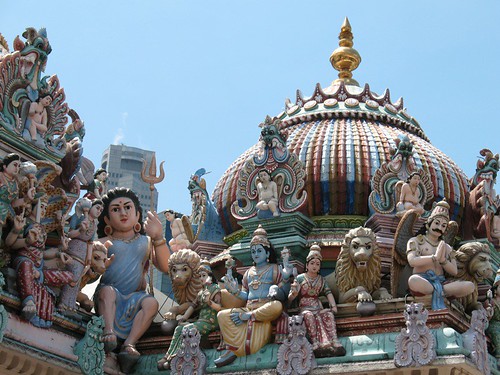Hexagram
The Hindu temple in Singapore is cartoonishly bright. Even moreso to me after the strict monotheism & austerity of mosques. Mosques can be rich enough, but all the decoration is functional. You won't find representations of anyone in painting or sculpture anywhere inside.
All the more fun to enter the endless & thoroughly represented Hindu pantheon. What you see here is part of the interior temple's roof.

Inside the temple we met a kindly Indian man wearing a chunky gold ring. The ring was marked with what I think of as the Star of David. The Seal of Solomon.
This is sort like finding a swastika in the Buddhist temples. Here in Singapore, I'd already seen the Star on a couple buildings & fountains around town, & wondered. It seemed unJewish to be so flashy with a symbol.
As it turns out, the hexagram is also an ancient symbol: the Hindu Shatkona, related to Shiva. The link there gives you some information, but I like better what the man at the temple had to say:
The '^' part of the star represents Mankind's spiritual quest, an upward appeal to the divine.
The 'V' is divine grace responding.
All the more fun to enter the endless & thoroughly represented Hindu pantheon. What you see here is part of the interior temple's roof.

Inside the temple we met a kindly Indian man wearing a chunky gold ring. The ring was marked with what I think of as the Star of David. The Seal of Solomon.
This is sort like finding a swastika in the Buddhist temples. Here in Singapore, I'd already seen the Star on a couple buildings & fountains around town, & wondered. It seemed unJewish to be so flashy with a symbol.
As it turns out, the hexagram is also an ancient symbol: the Hindu Shatkona, related to Shiva. The link there gives you some information, but I like better what the man at the temple had to say:
The '^' part of the star represents Mankind's spiritual quest, an upward appeal to the divine.
The 'V' is divine grace responding.

0 Comments:
Post a Comment
<< Home